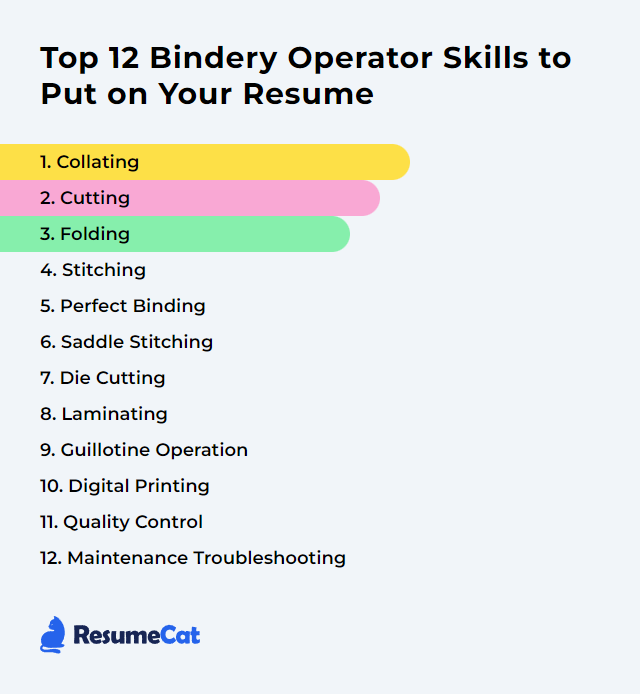Top 12 Bindery Operator Skills to Put on Your Resume
In print production, a bindery operator’s resume has to show the blend—precise hands, sharp eyes, cool judgment under pressure. Technical depth meets steady workflow. When those skills are front and center, hiring managers notice, because it signals reliable output, clean finishes, and fewer surprises on the floor.
Bindery Operator Skills
- Collating
- Cutting
- Folding
- Stitching
- Perfect Binding
- Saddle Stitching
- Die Cutting
- Laminating
- Guillotine Operation
- Digital Printing
- Quality Control
- Maintenance Troubleshooting
1. Collating
Collating is the controlled gathering of sheets or signatures into the exact order needed before binding, so the final piece reads right from cover to back page.
Why It's Important
If the sequence goes off, everything downstream does too—binding, trimming, delivery. Proper collating keeps the whole job on track and the customer happy.
How to Improve Collating Skills
To tighten up collating, focus on the fundamentals and keep drift at bay:
Routine maintenance: Clean feed stations, sensors, and suction systems; verify timing belts and grippers are crisp.
Precise setup: Match pockets, guides, and air settings to the stock and run length. Slow down to speed up.
In-line checks: Pull samples early and often; confirm page order, orientation, and signature integrity.
Cross-training: Learn multiple collator models and signature patterns; versatility shortens changeovers.
Lean flow: Stage stock and pallets logically; remove excess handling and motion from the cell.
Build habits that catch errors before they snowball.
How to Display Collating Skills on Your Resume
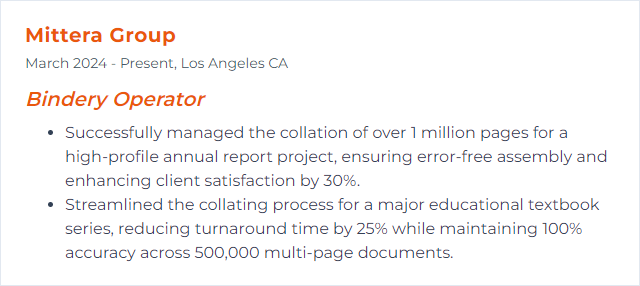
2. Cutting
Cutting trims printed stacks or sheets to exact dimensions with straight, repeatable edges using precision knives and programmed stops.
Why It's Important
Clean cuts mean square books, even bleeds, and parts that fit downstream equipment. Miss by a hair and you’ll see it—in bind, in fold, in waste.
How to Improve Cutting Skills
Lift accuracy. Reduce rework. Keep fingertips safe:
Sharp blades: Rotate and sharpen on schedule; dull knives crush fibers and cause edge fray.
Measure twice: Confirm trim sizes against dummies and job tickets; program stops carefully.
Right tools: Use proper sticks, joggers, and air tables; match clamps and backgauge pressure to stock.
Safety first: Test light curtains, two-hand controls, and guards at the start of each shift.
Quality gates: First-off and mid-run checks for size, squareness, and stack alignment.
Documentation: Save programs for repeat work; note quirks by paper brand and grain.
How to Display Cutting Skills on Your Resume
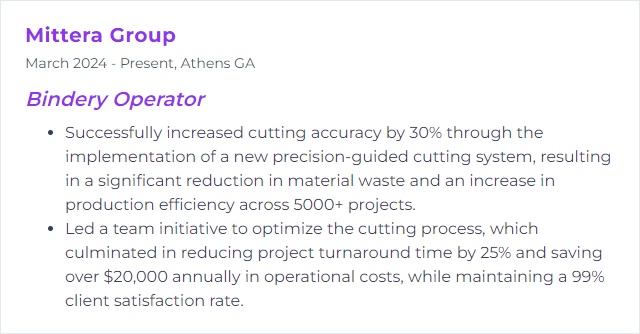
3. Folding
Folding creases stock along planned lines so brochures, signatures, and mailers land exactly as designed—clean, crisp, and consistent.
Why It's Important
Bad folds ripple into bind, trim, and mailing. Good folds lock in registration, fit, and the look a customer expects.
How to Improve Folding Skills
Dial in both the machine and the paper:
Careful setup: Align guides, plates, rollers, and stops to the grain and weight; run test sheets and tweak.
Roller condition: Clean and deglaze; set nip pressure evenly to prevent marking and skew.
Stock choice: Match coatings and weights to fold type; pre-score where cracking lurks.
Environment: Stabilize humidity and temperature; let paper acclimate before the run.
Quality control: Use check samples every lift; verify panel sizes, registration, and parallelism.
Operator training: Practice complex patterns—gate, roll, map, signature—until setup time drops.
How to Display Folding Skills on Your Resume
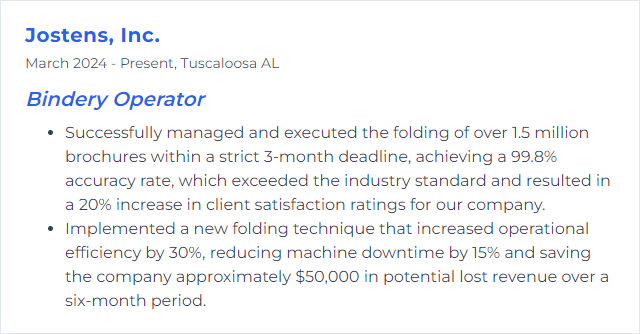
4. Stitching
Stitching fastens pages with wire staples, typically through the fold or along an edge, creating booklets and brochures that hold up in the hand.
Why It's Important
Strong, straight stitches keep pages where they belong and give the finished piece a tight, professional look.
How to Improve Stitching Skills
Consistency above all. Then speed:
Preventive care: Clean clinchers and heads; replace worn drivers and anvils before defects show.
Setup discipline: Center heads, calibrate wire length, and set crown height to match thickness.
Quality checks: Tug-test samples; look for skew, bulging, or bird-caging and adjust immediately.
Materials: Use high-quality wire and correct diameters for thin vs. thick books.
Speed control: Back off RPM on heavy stocks or complex nests; stability beats haste.
Cross-train: Learn both saddle and side stitching nuances to cut make-ready time.
How to Display Stitching Skills on Your Resume
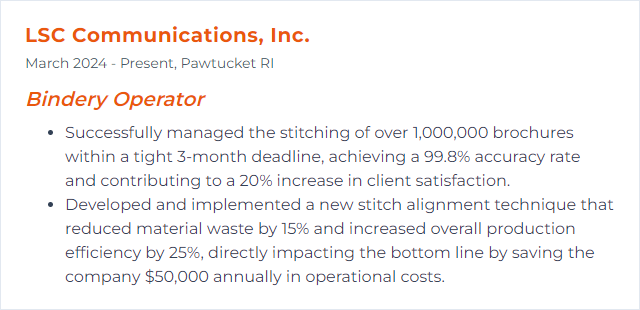
5. Perfect Binding
Perfect binding glues a milled spine to a wraparound cover, giving books a flat spine and a sleek profile.
Why It's Important
It looks polished, stacks well, and carries spine text—great for catalogs, manuals, and trade books where presentation matters.
How to Improve Perfect Binding Skills
Small adjustments create big durability:
Spine prep: Mill or notch evenly for better glue bite; remove dust that sabotages adhesion.
Adhesive choice: Match EVA for speed and economy, PUR for flexibility and strength on tough stocks.
Cover fit: Measure book blocks precisely; score covers to the real caliper, not the guess.
Environment: Keep glue temps steady; control shop climate so cure times don’t wander.
Machine care: Clean glue pots, rollers, and nippers; verify backups and clamps are square.
Materials: Choose compatible papers and coatings; consider grain direction to reduce spine cracking.
Testing: Pull-and-drop tests during setup; tweak glue film and dwell until it passes.
How to Display Perfect Binding Skills on Your Resume
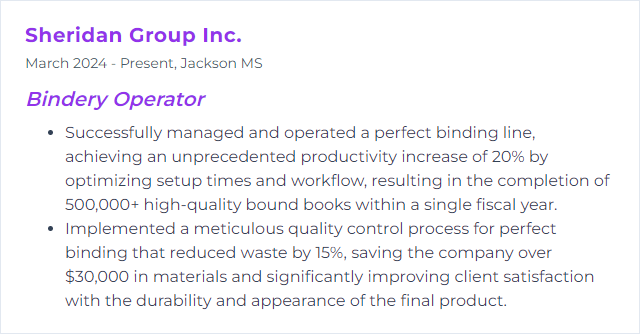
6. Saddle Stitching
Saddle stitching gathers folded signatures over a saddle and staples them through the fold—fast, tidy, cost-effective for shorter books and magazines.
Why It's Important
It’s quick, economical, and durable for mid-page counts. The staple sits right in the fold, keeping spreads flat and readable.
How to Improve Saddle Stitching Skills
Stability and flow are the game:
Prep cleanly: Sort, jog, and align signatures; verify pagination before loading hoppers.
Machine calibration: Set head position, wire length, and clinch angle to the book thickness.
Quality loop: Inspect every few cycles—stitch position, skew, trim creep, face trim tearing.
Score thick covers: Pre-score to prevent cracking at the fold line.
Workflow: Balance feeders, keep a steady pace, and stage pallets to minimize stops.
How to Display Saddle Stitching Skills on Your Resume
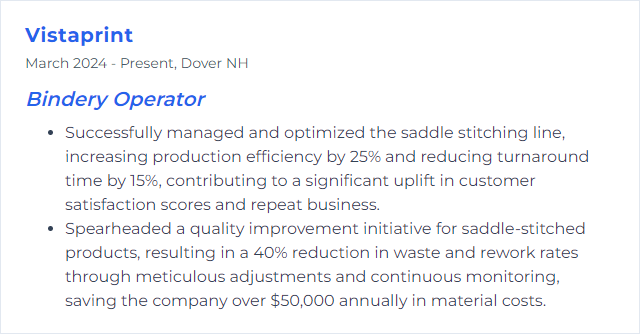
7. Die Cutting
Die cutting uses a custom steel rule to punch shapes, windows, and intricate outlines into paperboard, labels, and specialty pieces.
Why It's Important
It unlocks design—packaging, tabs, pockets, shapes—while keeping edges clean and repeatable across large runs.
How to Improve Die Cutting Skills
Precision in setup pays for itself:
Maintenance: Replace dull rules and nicked plates; check make-ready builds for even pressure.
Material conditioning: Let stock acclimate; fan and jog to reduce misfeeds and curl.
Test runs: Run short proofs to tune pressure, registration, and stripping before full speed.
Die quality: Specify correct rule heights, bevels, and ejection rubber for the stock and layout.
Stripping efficiency: Optimize waste removal; clean nicks prevent tearing and hang-ups.
Workflow: Organize tools, dies, and makeready kits so changeovers don’t sprawl.
How to Display Die Cutting Skills on Your Resume

8. Laminating
Laminating bonds a clear film to printed sheets, guarding against scuffs, moisture, and handling while adding sheen or a soft-touch feel.
Why It's Important
It extends life and elevates look-and-feel—menus, covers, presentation pieces, and retail materials survive the grind.
How to Improve Laminating Skills
Smooth finish, no bubbles, no silvering:
Calibrate: Set temperature, pressure, and tension to the film type and ink coverage.
Film selection: Choose gloss, matte, scuff-resistant, or soft-touch films appropriate to use and stock.
Clean rollers: Keep rollers debris-free; contamination prints defects into every sheet.
Speed vs. heat: Balance line speed with dwell time; cold spots and rushing cause lift.
Preventive maintenance: Inspect bearings, heaters, and nip controls regularly.
Practice: Test on short stacks; document settings by paper, coating, and film.
How to Display Laminating Skills on Your Resume

9. Guillotine Operation
Guillotine operation cuts large stacks to size with a straight, razor-sharp blade and programmable backgauge for repeat accuracy.
Why It's Important
It sets final dimensions. One bad trim throws off the whole job—covers won’t match, spines drift, edges look rough.
How to Improve Guillotine Operation Skills
Accuracy, safety, repeatability:
Safety systems: Verify two-hand controls, light curtains, and guards; never bypass protections.
Blade care: Sharpen on schedule; use fresh cutting sticks; monitor edge quality constantly.
Programming: Store cut sequences for repeats; label them clearly to prevent mix-ups.
Alignment: Square stacks tightly; use air tables and jogging to reduce skew and draw.
Lean setup: Stage lifts, pallets, and ream breaks to keep the cutter feeding without idle time.
Training: Standardize procedures based on current industry safety and quality guidelines.
How to Display Guillotine Operation Skills on Your Resume
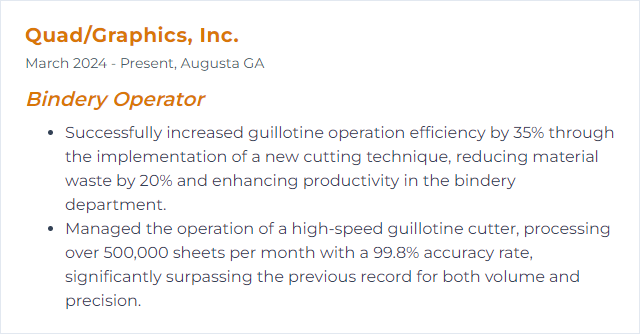
10. Digital Printing
Digital printing outputs directly from files to press without plates, enabling short runs, versioning, and fast turnarounds that flow straight into finishing.
Why It's Important
Jobs move fast. Bindery needs to match that pace—finishing stock with variable data, mixed substrates, and quick changeovers.
How to Improve Digital Printing Skills
From press to bind, keep it tight:
Maintenance: Keep engines calibrated; color and registration stability saves finishing headaches.
Software/DFE updates: Use current workflows for imposition, creep, and finishing marks.
Material selection: Choose papers tested for digital heat and toner/ink adhesion to avoid cracking.
Workflow integration: Align print queues with bindery capacity; sequence jobs by stock and finish.
Quality checks: Verify coverage, curl, and lay-flat before folding or binding.
Cross-training: Understand both sides—press behavior and finishing limits—so setups line up.
How to Display Digital Printing Skills on Your Resume

11. Quality Control
Quality control means inspecting, measuring, and verifying that every stage—collate, fold, stitch, trim, bind—meets spec before it ships.
Why It's Important
It stops defects early, protects margins, and builds trust. Fixing at the end costs more than catching at the start.
How to Improve Quality Control Skills
Build a system, not just spot checks:
Clear specs: Confirm tolerances, pagination, and finishes before setup; use signed dummies.
Calibration: Keep machines aligned and verified; measure, don’t assume.
Checklists: Stage-by-stage QC—samples pulled and logged at defined counts.
Root-cause fixes: When a defect appears, solve the cause, not just the symptom.
Feedback loop: Share misses and wins in shift huddles; update standard work.
Lean mindset: Reduce variation, scrap, and rework through continuous improvement.
How to Display Quality Control Skills on Your Resume
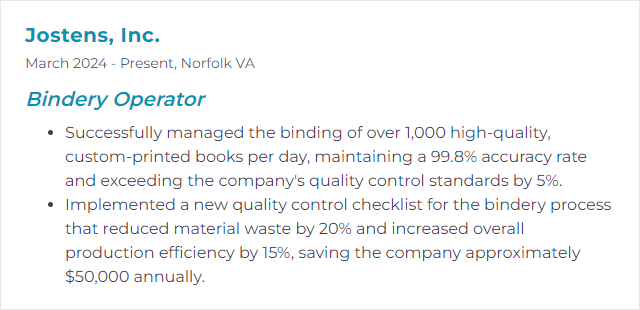
12. Maintenance Troubleshooting
Maintenance troubleshooting is the methodical hunt for mechanical, electrical, or setup faults that slow or stop bindery gear—and the fixes that keep it humming.
Why It's Important
Less downtime, more throughput. Quick diagnoses protect schedules and the quality of everything rolling off the line.
How to Improve Maintenance Troubleshooting Skills
Think systematically, act deliberately:
Know the machines: Study manuals, parts diagrams, and common-fault checklists.
Standard method: Use a step-by-step approach—verify symptoms, isolate variables, test, confirm, document.
Preventive schedules: Lubricate, tighten, and replace wear parts before failure.
Diagnostic tools: Keep gauges, meters, and alignment tools at hand; label and store them well.
CMMS use: Track maintenance history, parts inventory, and downtime to spot patterns.
Skills training: Refresh on pneumatics, sensors, and servo basics; shadow experienced techs.
Spare strategy: Stock critical components so small faults don’t become long outages.
How to Display Maintenance Troubleshooting Skills on Your Resume

